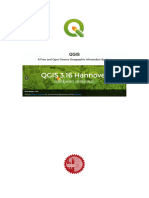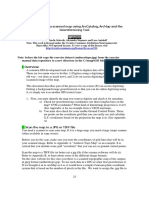Yurchenko Cad Assignment2
Uploaded by
api-445531772Yurchenko Cad Assignment2
Uploaded by
api-445531772Technical Memorandum
Project: Deliverable 9305-D2 - CAD and GIS
Ms. Kelly Dell, C.Tech
Client: Prepared By: Tetiana Yurchenko, B.Sc.
GISC9315 Instructor
35 Taylor Rd. Niagara-on-the-
Lake L0S 1J0
Subject: Feature Sources / Map Output
Date: April 8, 2019 Deliverable 2
1. Introduction
The purpose of this assignment is to create a Digital Elevation Model of Redding. This document
describes a step-by-step methodology that was used for creation a 3D map, including assigning
the spatial reference, applying exaggeration, creating a hillshade, stylizing the roads, etc. The map
shows an exaggerated 3D model of the city of Redding with contour lines where every 4th is a
major contour and roads within the territory. The assignment also aims to develop knowledge of
styling images by editing the style of the layers and creating appropriate map output with the
legend, north arrow, scale bar, and metadata information. Map Book is created in order to show
the details of smaller portions of the overall map. AutoCAD Map 3D 2018 software was required
to complete this assignment.
The area of interest is the city of Redding that is located in California, USA (Figure 1).
Tetiana Yurchenko
1
tatianayu20@gmail.com
Page
192 Queenston St, St. Catharines, ON
Figure 1 Area of interest. City of Redding
Tetiana Yurchenko
2
tatianayu20@gmail.com
Page
192 Queenston St, St. Catharines, ON
2. Methodology and parameters used
2.1 Assign coordinates
First, the map was created from map2d.dwt template. Once the template was opened, it was saved
as .dwg file in an appropriate location with the correct name. The coordinate system was set to
NAD27 California State Planes, Zone 1(401) US Foot as it was required by Terms of Reference
(Dell, GISC9315 D2 Terms of Reference, 2019).
It can be done using the Map Setup ribbon Assign tool and then typing the name of the
coordinate system in the search (Figure 2).
Figure 2 Assign coordinate system
2.2 Connect Raster Source
Raster file REDDING_CA1.dem was connected through Display manager Data Connect to
Data, selecting Add Raster Image option and defining the file path (Figure 3).
Tetiana Yurchenko
3
tatianayu20@gmail.com
Page
192 Queenston St, St. Catharines, ON
Figure 3 Connect to raster source
After the confirming coordinate system and file path, Add to Map function was used to display the
raster (Figure 4).
Figure 4 Connect to raster source - confirm coordinate system and path
Tetiana Yurchenko
4
tatianayu20@gmail.com
Page
192 Queenston St, St. Catharines, ON
2.3 Theme selection
After connecting to raster, it is displayed with a single green colour. Style editor was used in order
to apply an appropriate height based theme palette to the raster image by selection height property
with equal distribution. It was defined that USGS DEM palette is the most suitable for this kind of
raster image. The range starts from brown as the lowest elevation and ends with light green and
white as the highest (Figure 5).
Figure 5 Theme palette
The result of theme change can be seen in Figure 6.
Figure 6 Theme result
Tetiana Yurchenko
5
tatianayu20@gmail.com
Page
192 Queenston St, St. Catharines, ON
2.4 Apply an exaggeration
The view has been set from 2D to 3D to represent model vertically. It was needed to use “Regen”
(Regenerate) command every time after 3D model modifications. 2x exaggeration was selected at
first, but later 3x exaggeration was appeared to be most appropriate as it highlights the relief of the
territory better. Figure 7 below shows the 2x exaggeration in 3D mode.
Figure 7 Exaggeration in 3D mode
2.5 Contour creation
In order to create contours layer, it was needed to right click on REDDING_CA1 Create
Contour layer (Figure 8).
Figure 8 Generate contour
Tetiana Yurchenko
6
tatianayu20@gmail.com
Page
192 Queenston St, St. Catharines, ON
As it can be seen the contour elevation interval was set to 50 feet as the most appropriate because
contours with less interval could cause the map overload and messy look. Major contour was set
to every 4 lines and labels were displayed as it was required by Terms of Reference (Dell,
GISC9315 D2 Terms of Reference, 2019). To display labels properly it was needed to change
contour style by selecting “Feature Label” for major contours. Figure 9 shows the properties
selected for contour text styling. Elevation index is selected as the label to display (Text content).
Figure 9 Contour style
2.6 Apply Hillshading
The hillshade for the DEM was created using Analyze Surface Hillshade tool. The sun direction
was set to 270 degrees (west), sun angle – to 60, that indicates early evening (Figure 10).
Tetiana Yurchenko
7
tatianayu20@gmail.com
Page
192 Queenston St, St. Catharines, ON
Figure 10 Hillshade settings
3. Roads data
Roads.sdf file was connected through Display manager Data Connect to Data, selecting Add
SDF Connection option, defining the file path, setting the coordinate system, and adding to the
map (Figure 11).
Figure 11 SDF Connection
Tetiana Yurchenko
8
tatianayu20@gmail.com
Page
192 Queenston St, St. Catharines, ON
Figure 12 partly shows the roads table that was used for querying (changing the appearance of the
roads within different scale ranges) later.
Figure 12 Roads table
This table contains information about street names, street types, length, and address data of 2396
records. There are such street types listed: ALLEY, ART, COL, HWY, LOCAL, MALL, PVT
MF, PVT MOBILE, PVT ROAD, UNIMPROVED. Among the street suffixes: Ave, Blvd, Cir, Ct,
Dr, Ln, Path, Pl, Rd, St, Ter, Trl, Walk, Way.
It was required to make only the major roads (ST_Type: ART, HWY, FWY, COL) visible from
3000 to infinity (Dell, GISC9315 D2 Terms of Reference, 2019). The new range from 3000 to
infinity was entered in the Roads style. Figure 13 shows the expression that was used in thematic
rules to select major roads.
Figure 13 Query for the roads in scale from 3000 to infinity
The new range from 0 to 3000 was entered in the Roads style with some thematic rules too, that
specifies the street types allowed. Thus, Figure 14 shows the expression that was used to select
minor roads.
Tetiana Yurchenko
9
tatianayu20@gmail.com
Page
192 Queenston St, St. Catharines, ON
Figure 14 Query for the roads in scale from 0 to 3000
Once the roads layer is added and specified by scale range, it can be stylized. It was also needed
to create labels for the roads in scale range 0 to 3000, using ST_NAME (Street Name) as a label
(Figure 15).
Figure 15 Text properties for the roads in scale 0 to 3000
Following queries can be displayed within the Roads table that makes viewing information easier.
For example, Figure 16 shows the roads visible within the range from 0 to 3000.
Tetiana Yurchenko
10
tatianayu20@gmail.com
Page
192 Queenston St, St. Catharines, ON
Figure 16 Query selection in the table
4. Map Layout and Map Book Creation
Map layout was created adhering to all standards. It shows a map of the DEM model of Redding,
CA with contours and roads. The layout contains the title, scale bar, north arrow, legend, and
metadata information.
Before creating a map book, roads needed to be clipped to the raster layer extent. In order to clip
roads to raster image Roads layer and raster were selected in Display Manager and right click on
Roads Query to filter Data Locate on Map Rectangle. The whole area of raster image was
selected by using this tool (Figure 17).
Figure 17 Clip the roads
It automatically creates the following expression (Figure 18):
Tetiana Yurchenko
11
tatianayu20@gmail.com
Page
192 Queenston St, St. Catharines, ON
Figure 18 Clip expression
Then Map Book is to be created. The “Create Map Book” window has various settings. In Sheet
Template section the template was selected, title block and adjacent sheet were specified. Scale
factor was set to 3000, so in the end, 6 tiles were created with that scale (Figure 19).
Figure 19 Sheet Template section
Tiling Scheme settings specify the area of interest and divides it to 6 portions (Figure 20 and
Figure 21).
Tetiana Yurchenko
12
tatianayu20@gmail.com
Page
192 Queenston St, St. Catharines, ON
Figure 20 Tiling Scheme
Figure 21 6 tiles
Naming Scheme option sets the names for each tile by naming rows with letters and columns
with a number, incrementing by 1 (Figure 22).
Tetiana Yurchenko
13
tatianayu20@gmail.com
Page
192 Queenston St, St. Catharines, ON
Figure 22 Naming Scheme
Legend was set to none and Sheet Set was created.
After that 6 tiles were created automatically, but some changes were made: the logo was added
and the date was written in American style (month, day, year).
Reference system was also added with scale 1:35000 by the US National Grid template (Figure
23).
Figure 23 Add reference system
Tetiana Yurchenko
14
tatianayu20@gmail.com
Page
192 Queenston St, St. Catharines, ON
6. Findings and conclusions
One of the biggest challenges for this assignment was creating a map layout, especially legend.
Sometimes it didn’t allow to edit the text or resize the elements, so the only way to fix that was to
close and open AutoCAD again. The legend was getting back to default every time the software
was restarted. The problem with the legend wasn’t solved.
Another problem that popped up was that AutoCAD wasn’t able to create .dwf file (Fatal error
with instant closing the software), but it was solved by restarting the computer.
Generally, AutoCAD crashed multiple times during the procedure.
As a conclusion, this assignment was done in order to create two types of spatial output: 3D Map
layout and 2D Map Book that shows 6 tails in details. The 3D DEM Model highlights the relief of
the city of Redding well with the pleasant choice of colours, vertical exaggeration and hillshade.
Map book was created automatically after specifying some setting, only minor edits were needed
after creation. All the tasks required were performed successfully. The assignment contributes to
a better understanding of AutoCAD tools, querying the data and getting familiar with map layout
and map books creation.
Tetiana Yurchenko
15
tatianayu20@gmail.com
Page
192 Queenston St, St. Catharines, ON
References
Dell, K. (2019). GISC9315 D2 Terms of Reference. Niagara College.
Dell, K. (2019). PowerPoint. CAD and GIS - Week 10 Styling Features. Niagara-on-the-Lake,
ON, Canada.
Dell, K. (2019). PowerPoint. CAD and GIS - Week 12 Map Output. Niagara-on-the-Lake, ON,
Canada.
Tetiana Yurchenko
16
tatianayu20@gmail.com
Page
192 Queenston St, St. Catharines, ON
APPENDIX
Tetiana Yurchenko
17
tatianayu20@gmail.com
Page
192 Queenston St, St. Catharines, ON
Tetiana Yurchenko
tatianayu20@gmail.com
192 Queenston St, St. Catharines, ON
You might also like
- CS 188 Introduction To AI Midterm Study GuideNo ratings yetCS 188 Introduction To AI Midterm Study Guide2 pages
- Tutorial_Workshop Introduction to Digital Mapping using QGISNo ratings yetTutorial_Workshop Introduction to Digital Mapping using QGIS15 pages
- Quantum GIS (QGIS) Raster Based Terrain Analysis TechniquesNo ratings yetQuantum GIS (QGIS) Raster Based Terrain Analysis Techniques7 pages
- Computer Applications in Geosciences - Assignment: Centre For Advanced Studies University of Delhi, Delhi-110007, INDIANo ratings yetComputer Applications in Geosciences - Assignment: Centre For Advanced Studies University of Delhi, Delhi-110007, INDIA22 pages
- Geo Graphy Document HDFGHDFKJGH Vbiobjig BNo ratings yetGeo Graphy Document HDFGHDFKJGH Vbiobjig B141 pages
- IOC-22 Hrishikesh Shirsat 111910136 Geo-Informatics Assignment4No ratings yetIOC-22 Hrishikesh Shirsat 111910136 Geo-Informatics Assignment459 pages
- Digitising On A Topographic Sheet: 1.1 GeoreferencingNo ratings yetDigitising On A Topographic Sheet: 1.1 Georeferencing15 pages
- Autodesk Raster Design 2006 Features & BenefitsNo ratings yetAutodesk Raster Design 2006 Features & Benefits8 pages
- Ohniakara Aspiring Global Geopark Project - Final Report - Yurchenko NwosuNo ratings yetOhniakara Aspiring Global Geopark Project - Final Report - Yurchenko Nwosu49 pages
- Deliverable 3 Georeferencing of Scanned Aerial Imagery and Change DetectionNo ratings yetDeliverable 3 Georeferencing of Scanned Aerial Imagery and Change Detection17 pages
- Deliverable 9301-D2 (Assignment #2) Data Classification - In-Class AssignmentNo ratings yetDeliverable 9301-D2 (Assignment #2) Data Classification - In-Class Assignment10 pages
- Deliverable 3 Arcgis Major Assignment: Tetiana YurchenkoNo ratings yetDeliverable 3 Arcgis Major Assignment: Tetiana Yurchenko15 pages
- Lecture 16 - Relational Database Design PDFNo ratings yetLecture 16 - Relational Database Design PDF24 pages
- Exponential Smoothing Forecasting Method PDFNo ratings yetExponential Smoothing Forecasting Method PDF2 pages
- University of California, Los Angeles Department of Statistics Statistics 100A Instructor: Nicolas Christou Exam 1 21 October 2010No ratings yetUniversity of California, Los Angeles Department of Statistics Statistics 100A Instructor: Nicolas Christou Exam 1 21 October 20104 pages
- HDL Programming Verilog VHDL D Flip FlopNo ratings yetHDL Programming Verilog VHDL D Flip Flop8 pages
- Lab 1b Introduction To Modeling and Simulation100% (3)Lab 1b Introduction To Modeling and Simulation38 pages
- Variability Management in Software Product Line Activity DiagramsNo ratings yetVariability Management in Software Product Line Activity Diagrams6 pages
- Classify Webcam Images Using Deep LearningNo ratings yetClassify Webcam Images Using Deep Learning17 pages
- Chapter 2. The Relational Model: ObjectivesNo ratings yetChapter 2. The Relational Model: Objectives37 pages
- Digital Image Processing Codes For EnggNo ratings yetDigital Image Processing Codes For Engg17 pages
- ECE 2222-Digital Design Lab: Course Instructor: Ms. Saba Zia Lab 2: Gate Level ModelingNo ratings yetECE 2222-Digital Design Lab: Course Instructor: Ms. Saba Zia Lab 2: Gate Level Modeling7 pages
- Smart Texture Magnification Filtering PDFNo ratings yetSmart Texture Magnification Filtering PDF10 pages
- Tutorial_Workshop Introduction to Digital Mapping using QGISTutorial_Workshop Introduction to Digital Mapping using QGIS
- Quantum GIS (QGIS) Raster Based Terrain Analysis TechniquesQuantum GIS (QGIS) Raster Based Terrain Analysis Techniques
- Computer Applications in Geosciences - Assignment: Centre For Advanced Studies University of Delhi, Delhi-110007, INDIAComputer Applications in Geosciences - Assignment: Centre For Advanced Studies University of Delhi, Delhi-110007, INDIA
- IOC-22 Hrishikesh Shirsat 111910136 Geo-Informatics Assignment4IOC-22 Hrishikesh Shirsat 111910136 Geo-Informatics Assignment4
- Digitising On A Topographic Sheet: 1.1 GeoreferencingDigitising On A Topographic Sheet: 1.1 Georeferencing
- 3D Shape Analysis: Fundamentals, Theory, and ApplicationsFrom Everand3D Shape Analysis: Fundamentals, Theory, and Applications
- Ohniakara Aspiring Global Geopark Project - Final Report - Yurchenko NwosuOhniakara Aspiring Global Geopark Project - Final Report - Yurchenko Nwosu
- Deliverable 3 Georeferencing of Scanned Aerial Imagery and Change DetectionDeliverable 3 Georeferencing of Scanned Aerial Imagery and Change Detection
- Deliverable 9301-D2 (Assignment #2) Data Classification - In-Class AssignmentDeliverable 9301-D2 (Assignment #2) Data Classification - In-Class Assignment
- Deliverable 3 Arcgis Major Assignment: Tetiana YurchenkoDeliverable 3 Arcgis Major Assignment: Tetiana Yurchenko
- University of California, Los Angeles Department of Statistics Statistics 100A Instructor: Nicolas Christou Exam 1 21 October 2010University of California, Los Angeles Department of Statistics Statistics 100A Instructor: Nicolas Christou Exam 1 21 October 2010
- Variability Management in Software Product Line Activity DiagramsVariability Management in Software Product Line Activity Diagrams
- ECE 2222-Digital Design Lab: Course Instructor: Ms. Saba Zia Lab 2: Gate Level ModelingECE 2222-Digital Design Lab: Course Instructor: Ms. Saba Zia Lab 2: Gate Level Modeling
































































































